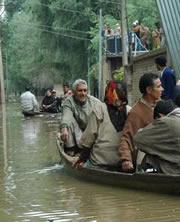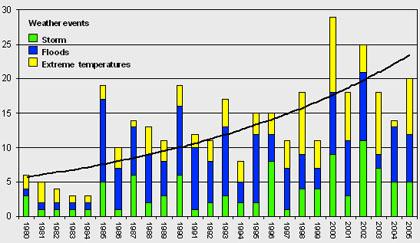 Residents leave a flooded neighborhood in Srinagar, India, this September.Empics
Residents leave a flooded neighborhood in Srinagar, India, this September.EmpicsIndia is having to cope with more frequent extreme weather events, and the densely populated subcontinent may see even more in future.
Extreme summer monsoon rains have become ever more common in central India during the past 50 years, probably as a result of global warming, Indian scientists report in this week's Science. Worse, more frequent and intense cloudbursts seem to come at the expense of the more drawn-out, moderate rains that are vital for the drought-prone region. The risk of severe droughts and floods may further increase if the warming trend continues, the authors conclude.
Most climate models predict more frequent extreme rainfall events if temperatures rise: warmer air can hold more water vapour, and that can cause more rain.
“It's all consistent with what climate models predict.”
Peter Höppe, Munich Re.
But the effect is hard to verify in the real world, chiefly because average temperatures have as yet increased only moderately. Besides, tropical monsoons are a complex climate feature with considerable variability on different time-scales, from years to millennia. Rainstorms are scattered and short-lived events, usually lasting no longer than two hours. Given so much variation between any given pair of weather stations, trends are easy to miss.
To get around this problem, Bhupendra Goswami, an atmospheric researcher at the Indian Institute of Tropical Meteorology in Pune, and his team, analysed data from more than 1,800 weather stations all over central India for the period 1951-2000. They found no significant change in seasonal mean rainfall for the area as a whole, comprising well over a million square kilometres. But the number of extreme events - rainfall exceeding 150 millimetres per day — has apparently doubled since the early 1950s, and heavy events exceeding 100 millimetres per day still show a 10 % increase per decade1.
Be prepared
It is unclear whether global warming can fully explain the observed changes. "We can only speculate at this point about the physical mechanism," says Goswami. "But even so, we clearly need to improve existing observation networks, warning systems and our general disaster preparedness."
 Munich Re
Munich ReMonsoon rain is vital for tropical South Asia. Central India, for example, is a dry region with great rainfall demand. But extreme rain, such as the record single-day 944 millimetres that killed more than 1,000 people in and around Mumbai on 26 July last year, can bring havoc. Flash floods and mudslides threaten people, crops and property alike, and often leave the government machinery in disarray.
The strength of the South-West summer monsoon, which is linked to surface air temperatures in the Eurasian region, has steadily increased over the past few centuries2. But stronger monsoons, which bring more rain overall, are not necessarily bad; in fact, they may even be beneficial for agriculture and vegetation. It is intense rainfall, rather than too much water over a season, that causes problems, says Anil Gupta, head of geology and geophysics at the Indian Institute of Technology in Kharagpur.
Time lag
Some suspect that the peak of Asian summer monsoons may also be shifting to a later time in the year, which could have severe implications for water management and flood risk (see 'Climate change blamed for India's monsoon misery'). But a systematic study has not been done on this question so far, nor does anyone know what might be causing the delay. Goswami and his team plan to study this question with their dataset.
ADVERTISEMENT
Whatever the trends, the effects are already being felt. The number of flood and weather-related disasters in India has significantly increased in the past 25 years, according to data compiled by the reinsurance company Munich Re. Only a small portion of the overall losses since 1980 — more than US$ 20 billion — have been covered by insurance.
"It's all consistent with what climate models predict," says Peter Höppe, head of Munich Re's geo risk department. "India is just exceptionally vulnerable. But we have every reason to assume that global warming will lead to more and more severe, floods and droughts in Europe and North America as well."
Visit our monsoonsontherise_in.html">newsblog to read and post comments about this story.
